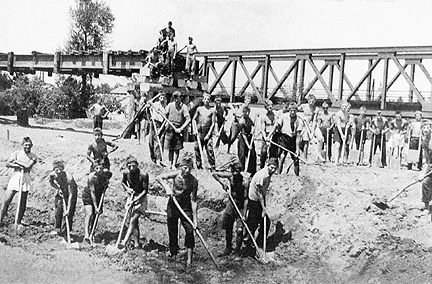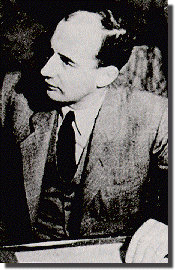Born the only child of upper-middle class Jewish parents in Budapest in 1928, Lantos grew up during a time when Hungary was slowly being taken over by the Nazis. When he was 10 years old, he bought his first newspaper--an experience he vividly recalls today. The headline read, "Hitler Marches into Austria."
"I sensed that this historic moment would have a tremendous impact on the lives of Hungarian Jews, my family and myself," he says. If only he knew.
When he was 16, German troops invaded his homeland--and along with them came Adolf Eichmann, with orders to exterminate the Jewish population of Hungary. By the end of the summer of 1944, most of the Jews outside of Budapest had been sent to Auschwitz.

The Nazis used Jewish labor battalions to build and repair important
communication links and bridges and to dig trenches on the Eastern Front.
Lantos was forced to work in a battalion similar to this one. Photo courtesy
of Film and Photo Department Archives, Yad Vashem Museum, Israel.
Lantos and other young Jewish men were sent to work camps. He was dispatched to Szob, a town 40 miles north of Budapest, where his forced labor group's duty was to maintain an important bridge on the Budapest-Vienna rail line.
The work was treacherous at best, and he experienced wild highs and lows--delight at watching Allied bombers destroy the bridge, yet frustration because he knew it meant he and his comrades would have to rebuild it. Then there was the day an air raid killed all the young workers except Lantos. "I was convinced I wouldn't survive," he says.
Despite his imprisonment, he managed to keep in contact with his family, and Annette Tillemann, a childhood friend who went into hiding with her mother shortly after the German invasion. Once, Lantos escaped from the camp but he was caught and "beaten to a pulp."
Desperate with what his life had become, and feeling he had nothing to lose, he tried another escape. When a guard wasn't paying much attention, he disappeared. His blue eyes and blonde hair fooled Nazi troops into thinking he was not a Jew, but the entire time he was trying to make his way back to Budapest, he was wracked with fear that his Jewish identity would be discovered if he were ordered by a Nazi soldier to drop his pants.

Raoul Wallenberg
He eventually found refuge in a Budapest apartment building rented by Swedish diplomat Raoul Wallenberg and under Swedish diplomatic protection. Wallenberg saved approximately 100,000 Hungarian Jews with his secret refuges and by providing fake Swiss passports. (To this day, Lantos remains deeply indebted to Wallenberg for saving his life. A portrait of Wallenberg--who disappeared after being imprisoned by the Russians--hangs behind his desk in the Rayburn House Office Building.)
"It was a three-bedroom apartment designed for one family," Lantos recalls, "And there must have been 50 to 60 people crowded into it." Noting Lantos' "Aryan" coloring, Wallenberg put Lantos to work helping out in an elaborate anti-Nazi underground, delivering a bottle of medicine or loaf of bread to Jews Wallenberg had in hiding throughout Budapest. Dressed in a military cadet's uniform, Lantos was able to move around undetected by Nazi authorities. His good deeds, however, were not based strictly on altruism or a desire to help his fellow man, but fatalism. "I probably wouldn't survive," Lantos thought at the time. "I decided I might be of some use.
"In retrospect, I was doing things I never should have done, because they took more courage than I'm sure I had."
As the war entered 1945, life in Budapest deteriorated. It was under constant shelling and the Germans and Russians engaged in house-to-house fighting. Then, at 3 a.m. on a cold January day, a Russian soldier burst into the safe house where Lantos was staying, liberating the teen-ager and his many housemates. By mid-January, the German army pulled out, leaving the Russians in control of the city. But Lantos' relief was short-lived--a search for his mother and the rest of his family ended in vain. They had all been killed.
Miraculously, Lantos was able to re-establish contact with Annette Tillemann, his old childhood friend who had gone into hiding during the German invasion. All he had was an old address of some of her family friends in Switzerland. He was not aware that Annette and her mother had escaped to Switzerland. He sent a letter, and somehow, even though the Hungarian postal system was in disarray, it got through. Stunned and thrilled to learn that Lantos was still alive, Tillemann was desperate to contact him. Knowing it was impossible to reach him by mail, she gamely boarded an old bus for an excruciating 10-day journey back to Budapest, with nothing more than a tiny parcel containing some food.
Her homecoming was devastating. She learned that her father, grandparents
and all but one relative who remained in the city had been killed. But she
was able to get word to Lantos that she was back in town, and after a year's
separation, they were reunited. They would never be apart after that, and
in fact, are still together after 49 years of marriage.
